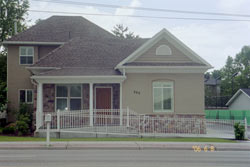 |
Ramp #1 (Good Ramp)
This attractive ramp is Linda's personal favorite. Not only did the designer/architect take the entire building into consideration when making this addition they actually did it right.
Covered by the porch roof the landing is over 72 inches square, more than adequate for opening a door undercover from the weather. This ramp is plenty wide for wheelchairs or other equipment and an attractive railing has been installed for extra safety. The switchback is wide and level with the rest of the ramp gently sloping to the sidewalk at the far side of the building. Individuals needing to load into a vehicle may do so safely out of main traffic at the sidewalk or around the back of the building
|
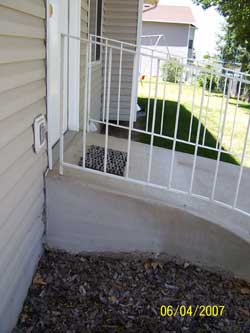 |
Ramp #2 (Bad Ramp)
Appropriately nicknamed, "The Ski Jump", this ramp begins at a height of 25 inches from ground level to door threshold making the slope a 25 inch drop in just under 4 ft. of length. The slope also banks 5 inches downward from the inside edge to the outside edge making it impossible for anyone in a wheelchair to navigate this ramp by themselves in either direction. The pitch, both vertical and horizontal, is too steep with a mid-pitch turn banked in the wrong direction. It is impossible to navigate the ramp with anything other than brute strength. Danger of roll-offs is high.
While this ramp does have some cover provided by a roof overhang, has adequate railing and width it does NOT have a flat landing at door level. It is impossible for a wheelchair user to hold themselves in place on the ramp and open the door at the same time. This includes power wheelchairs as well.
Fortunately this ramp is used only as an emergency egress, with assistance, as the family has improved ramp access at the front entrance of the home.
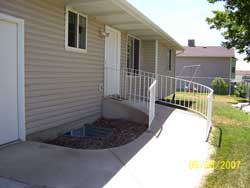 |
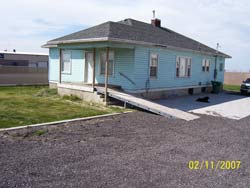 |
Ramp #3 (Bad Ramp)
A large flat porch covered by a porch roof provides a good landing for this ramp. But. There are no railings! The location of the front door on the edge of the porch makes this a dangerous entry point for a wheelchair user as the chair must be navigated close to the edge of the porch in order to gain entry through the door.
The downhill slope of the ramp is very close to the required 1:12 slope but there are no railings. Danger of rolling off either side of the ramp is high.
A further danger is noted in the deep gravel at the end of the ramp. Any wheelchair rapidly descending the ramp could immediately become mired in the deep gravel causing an abrupt stop of the wheelchair. This could result in a front flip over, pinning the wheelchair occupant underneath the wheelchair and causing injury. There is no flat loading area for transfer to a vehicle. Wheelchair users must sit in the gravel or on the sloped end of the ramp in order to transfer. A flat, solid concrete/asphalt landing zone 60"x60", minimum, at the base of the ramp is recommended.
|
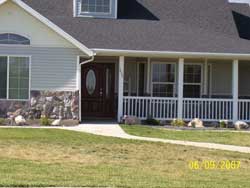 |
Ramp #4 (Good "Not quite a ramp" Entry)
This entry is an excellent example of a rampless entry. Using the ground slope the architect and contractor built this home specifically with a ground level entrance in mind. Sidewalk slope is minimal, a large porch covers the doorway and the doorway is navigable. Individuals unable to use stairs can easily access this home.
This is also an excellent example of a "visit-able" entry. Individuals at any level of physical ability may access the home. Sure makes it easy for Grandma to come and visit.
|
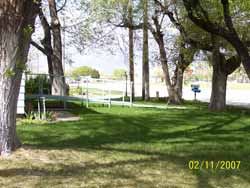 |
Ramp #5 (Fair Ramp)
When viewed from the side this ramp is a good illustration of excellent 1:12 slope. However. Upon closer examination this ramp has 2 specific problems.
Problem #1: No landing at the top of the ramp at the front door. Family members must navigate through a screen door and the front door, with opposite swings, to gain entrance.
Problem #2: This ramp ends at the curbside of a very busy high-speed 4-lane freeway. Loading into a vehicle at this curb can be dangerous. The optimal solution would have been to provide a 90` turn to the driveway immediately adjacent to the home where a safe loading zone can be accessed.
Another consideration is the amount of snow, which ends up piled at the end of the ramp during the winter. Occupants of this home must clear the curbside of snow shoved off the highway by County snowplows after winter storms before they can maneuver the car to the curb. Again, a safe loading zone out of traffic and away from seasonal snow build up at the curb is the preferred option.
|
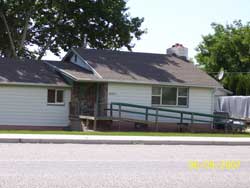 |
Ramp #6 (Ramp Needs Upkeep)
Note that while this ramp is an excellent structure overall, with a large covered landing, adequate ramp width and appropriate slope it lacks proper maintenance.
Take a closer look and see if you can locate where 2 sections of the railings are missing? These are strategic areas where railings are an absolute must! Anyone in a wheelchair could very easily roll right off right under the top rail, possibly incurring significant injury upon landing on the lawn. This is a simple repair requiring 20 minutes, a 2"x4" cut to the proper length and several galvanized L-brackets and screws. A less than $20.00 fix. Ramp maintenance is crucial for safety!
|
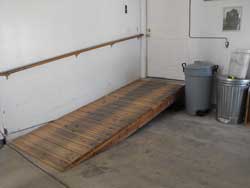 |
Ramp #7 (Good Concept -Incomplete Execution)
This ramp was built inside the home owner's garage. This is an excellent application for entry and exit during bad weather. However, there are several problems which need to be addressed.
- Missing safety railings. Note the railing attached to the inside wall. While this is at standard height it is in the wrong place! A full railing on the OUTSIDE edge of the ramp is an absolute must to prevent roll off onto the concrete floor.
- Missing flat landing. While the interior door is easily reached the individual must hold steady on a decline while opening the door with a key. A minimum 60 inch square flat landing is recommended for safety.
- Steep slope. This ramp measures 19 inches from floor to the door threshold yet is only 10 feet in length. In order to meet the standard 1:12 slope this ramp should measure 19 feet in length.
Overall the concept of an interior ramp access is a good one. Attaching the ramp to the other wall, next to the entry door, would allow enough space to provide a flat landing and a full 19 foot long ramp, the required 1:12 slope. Family members would still be able to access both the family vehicle and the ramp with ample room in this 3-car garage.
|
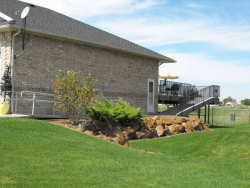
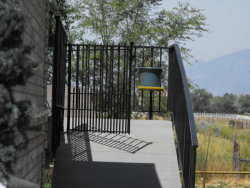 |
Ramp # 8 (Second Story Deck Ramp)
Two ramps in one, this ramp system was built to allow access to the family second story deck at the rear of the home. Two separate ramps have been used, a prefabricated ramp at the lower end near the garage and a built in deck system from garage level to the deck above. The slope does not meet ADA, being shorter in length than the height requires, but has railings and a locking gate at the top to prevent accidental roll offs. A full railing system along the entire length of both ramp additions is suggested for added safety. |
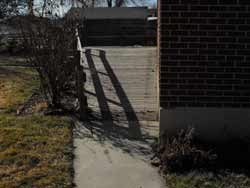
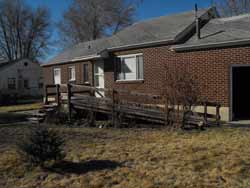 |
Ramp #9 (Good Ramp, Just Weathered)
This ramp is attached to the only accessible entrance to the house. The family chose redwood deck materials to construct a large flat landing and a tapering ramp. There is plenty of flat space at the top to navigate around the screen door as well as allow assistance from others, as needed. A porch covering would be helpful during inclement weather. The material chosen for the transition from ramp to sidewalk is an interesting but effective one. ½ inch thick diamond plate steel is used to create as small a lip as possible. This item was purchased at a local body shop specializing in truck modifications for a few dollars. This ramp will require yearly maintenance. The redwood decking needs to be oiled and sealed yearly to prevent deterioration. |
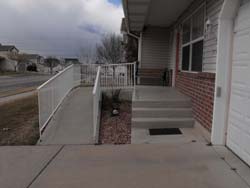 |
Ramp #10 (Fair Ramp)
This ramp posed an interesting problem for the contractor. The front door threshold is 4 feet above the curb at sidewalk level a short 25 ft. away. Making the ramp a straight shot from door to front sidewalk was impossible, due to the slope. The contractor chose to attach the ramp to a 4 ft. deep porch landing and then construct the ramp using a sharp left turn to take the majority of the ramp length horizontally along the front slope. While still steep this ramp is fairly close to the ADA recommended 12:1 pitch, has a covered landing and adequate width for wheelchair users to navigate. There are two drawbacks. The inside railing of the left angled corner turn can catch rear casters if the wheelchair is not carefully maneuvered through the turn. Our recommendation would be to widen the corner ramp surface by at least 3 inches to compensate.
The second drawback is the landing is sloped away from the front door making the elevated door threshold difficult to navigate and increasing the difficulty of a wheelchair user to reach the door handle and open the door without difficulty. Our recommendation is to adjust the slope more to level and replace the current doorsill with an ADA approved weatherproof door sill/ threshold.
|


















